Locomotives -
Operational Locos -
Locos under overhaul -
Locos on static display -
Locos formerly based on the Bluebell
Loco Roster -
Loco Stock List -
Loco Works News -
Join the Loco Dept


British Railways Standard Class 4
4-6-0 Locomotive No. 75027
One of the last steam locomotives working
on British Railways
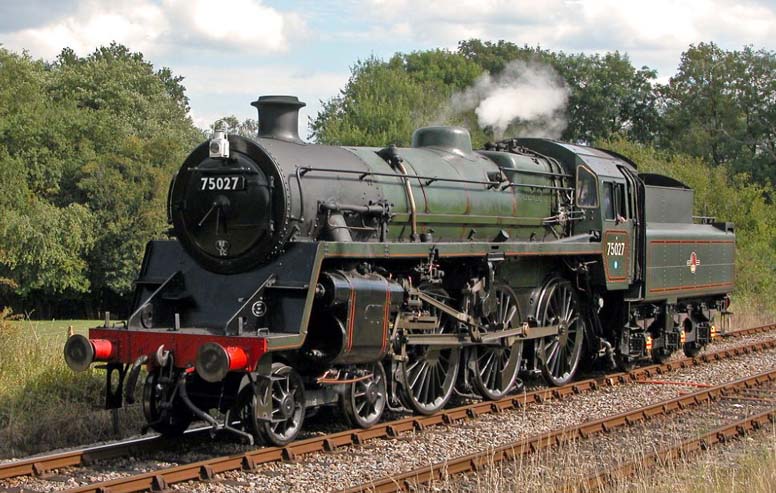
No.75027 seen here during the run-round at Kingscote on 27 August
2006.
Derek Hayward
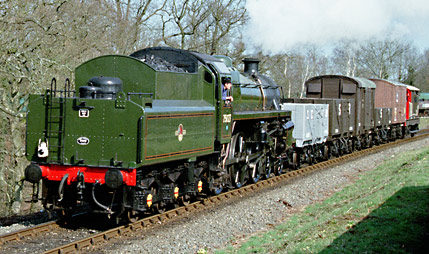
Although three narrow-gauge locos continued to work
the Vale of Rheidol line, regular steam-hauled trains ended on BR
in August 1968. 75027 was withdrawn from BR service from
Carnforth shed (BR code 10A) at that time. It was purchased by
the late Charlie Pyne, then one of our working members, and
generously donated by him (anonymously) to the railway.
The Standard Class 4 4-6-0 tender engines were designed as a
lighter version of the Class 5 4-6-0 (like 73082). Similar in concept to the GWR Manor
class, their greater route availability allowed them to haul both
freight and passenger services on the country's secondary routes.
Some, with larger tenders, were allocated to the Southern Region
but 75027 is essentially a foreigner to the south, having been
built for the Western Region (the blue disc painted on the
cab-side is its WR route availability code). However, it may not
have been a stranger to the south, as it was noted at Bournemouth
West in 1962, during its time on the Somerset and Dorset
line.
75027 was ordered under the 1952 build programme as one of a
batch of locomotives comprising Nos. 75020-75029. Production of
this batch of locomotives (plus numerous others) was delayed due
to a national steel shortage, during which the Government
prioritised steel output towards export products. As a
consequence, 75027 was not completed until May 1954 at BR Swindon
Works as part of Lot No. 400, although the builder's plates show
1953 as the build date. It was coupled to a type
BR2 small tender and would have been outshopped in BR lined black
livery with an early BR crest on the tender. After 1956 the BR
Regions were given a little more autonomy in the matter of loco
liveries, and one result of this was the WR painting more
locomotives in green – 75027 being an example.
The photo above shows No.75027
approaching Horsted Keynes with a goods train in 1998.
Initially allocated to Laira (Plymouth) shed (83D), it was
transferred to Reading (81D) in September of that year. Transfers
of locomotives were generally recorded at the end of a Period,
each being four weeks; thus there are 13 Periods in a year. This
transfer was recorded at the end of Period 10 of 1954.
Ironically the Modernisation Plan published by BR on 1st
December 1954 called for the elimination of steam traction. The
service history of 75027 illustrates the decline of steam over
the next thirteen years.
At the end of 1954 (P13/'54) the loco was transferred to
Oxford (81F), where it remained until February 1959 (P2/'59).
75027 then moved to Swindon (82C), followed by Templecombe (82G)
on the Somerset & Dorset line in February (P2) 1960.
At the end of the 1962 summer timetable all through services
were diverted away from the S&D route, so November 1962 saw
the loco on the Cambrian Coast route, being shedded first at
Machynlleth (89C), then Croes Newydd (6C) in March 1963. This
former GWR shed in Wrexham had just been transferred to the
London Midland Region under boundary changes, which also brought
the narrow-gauge Vale of Rheidol line under LMR control. BR steam
ended on the Western Region in 1964.
February 1965 saw the loco allocated to Liverpool (Bank Hall)
(8K) where it remained until October 1966, the shed being closed
completely on 22nd of that month. Bank Hall's allocation of locos
was transferred to Aintree (8L); 75027 stayed there for just one
month (Aintree itself was booked for closure on 6th March 1967,
but finally closed on 12 June).

From November 1966 until January 1967 the loco was allocated
to Skipton (10G) where one of its duties was to serve Swinden
quarry on the Grassington branch. The lower axle-loading of the
75xxx class made them ideal engines for this work. Skipton was
also booked for closure on 6th March 1967.
From January to April 1967 75027 was allocated to Carnforth
(10A) but it spent at least some of that time in store at
Carlisle Upperby (noted there in April with 75019 and 75039).
75027 was then transferred to Tebay (12E) until January 1968;
there it was one of nine similar locos rostered for banking
duties on the Grayrigg Incline between Oxenholme and Tebay. Tebay
shed had previously been booked for closure in that month, with
the banking duties due to be taken over by diesel locos on 1st
January. The replacement Clayton (D85xx later, Class 17) Type 1
class locomotives had been introduced in 1962 but were
particularly unreliable, so Class 4 steam locos were still used
occasionally to cover diesel failures until banking was deemed no
longer necessary for diesel-hauled trains.
During the summer of 1968, with the last few steam locos in BR service frequently being cleaned by enthusiasts and with smokebox details picked out in white, No. 75027 is seen getting away from Swinden Quarry near Grassington in this photo provided with thanks to and © Richard Manton.
The final shed for 75027 was Carnforth (10A), where it was one
of the last five of the class in service. 75027 was noted as the
last banker at Oxenholme on 4th May 1968 – banking was no
longer available at Oxenholme after this. It also continued to
work on the Grassington branch, being noted there in May and
June. A week before the end, 75027 and 75019 worked an
enthusiasts' special organised by the Severn Valley R.P.S.
Withdrawal from BR service came with the end of steam on 3rd
August 1968.
When it arrived at Sheffield Park in January 1969, 75027
appeared to be far larger than was necessary on the Bluebell
Railway of the late 1960s. It ran almost immediately after
delivery, largely in ex-BR condition (albeit with its grimy green
paintwork well cleaned) and soon proved its worth as we entered
the 1970s. After a repaint in 1971 it continued as the mainstay
of the fleet until 1975.
A relatively modern loco, capable of hauling heavier trains up
our 1-in-75 gradients, it was very much appreciated. It remains
to this day the ideal locomotive for many of our trains, powerful
yet economical, attractive and easy to prepare and maintain.
Given an overhaul in 1978, it ran for another period of
service through much of the 1980s, and again for a decade
following a further general repair completed in 1997. It was
withdrawn from service to await another overhaul at the end of
February 2007.
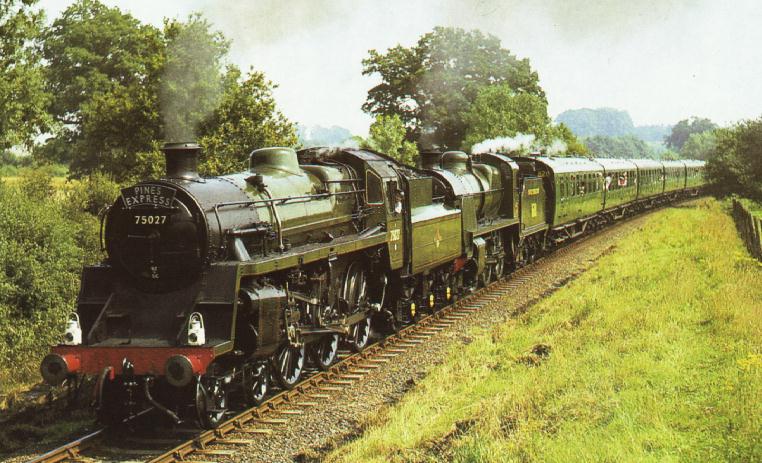
No.75027 in a classic Somerset & Dorset double-heading
combination with U-class No.1618.
Mike Esau
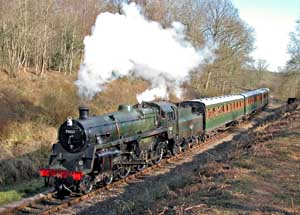
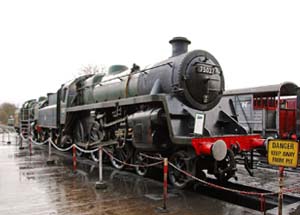
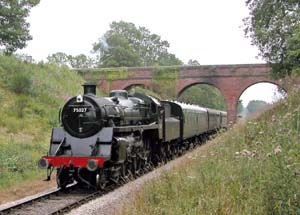
Three photos of 75027 by Derek Hayward.
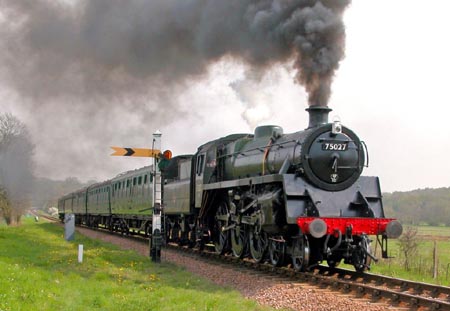 Class:
Standard Class 4 Class:
Standard Class 4
Wheels: 4-6-0
Class introduced: 1951
Designed: at Brighton; R.A. Riddles
Built: 1954 at BR Swindon Works
Purpose: Mixed traffic
Total number built: 80
Number: 75027
Arrived on Bluebell Railway: 22 January 1969
Last Operational: end of February 2007
Current status: Static display awaiting overhaul
Length: 50ft
Weight: Engine 69 tons, Tender 42 tons 3cwt
Water capacity: 3,500 gallons
Coal capacity: 6 Tons
Boiler pressure: 225 lb/sq.in
Driving Wheels: 5ft 8in diameter
Cylinders: (two, outside) 18" x 28"
Tractive effort: 25,515 lbs
BR power classification: 4MT
Right: The loco passes Sheffield Park distant
signal (Derek Hayward)


Return to BRPS Home Page,
to the Timetable or to Special
Events
Locos Intro -
Operational Locos -
Locos under overhaul -
Locos on static display -
Locos formerly based on the Bluebell
Loco Roster -
Loco Stock List -
Loco Works News -
Join the Loco Dept
Visitor Info. -
Museum -
Trust -
Catering -
Contacts -
What's New -
Projects -
Locos -
Carriages & Wagons -
Signals -
History -
Other -
Links -
Search -
FAQ
Why not become a BRPS Member? -
Get more involved as a Volunteer
Your ideal Film/TV location?
 © Copyright July 2008 by Martin Skrzetuszewski, Jon Elphick and Richard Salmon
© Copyright July 2008 by Martin Skrzetuszewski, Jon Elphick and Richard Salmon
Photos © copyright Mike Esau, Richard Manton, Richard Salmon and Derek Hayward
Last updated by Nick Beck and Richard Salmon, 3 September 2013 and 5 June 2024
© Copyright BRPS. Privacy Policy
|













